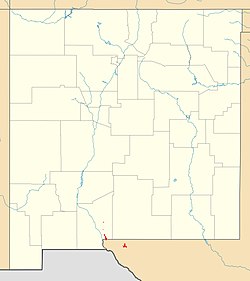라 참치 포메뉴
La Tuna Formation| 라 참치 포메뉴 | |
|---|---|
| 층서 범위: | |
| 유형 | 형성 |
| 언더라이즈 | 베리노층 |
| 오버라이즈 | 란체리아 층, 조타대 |
| 두께 | 340~423피트(104~420m) |
| 암석학 | |
| 기본적인 | 석회암 |
| 다른. | 셰일 |
| 위치 | |
| 좌표 | 31°58º0ºN 106°31′30″w/31.96667°N 106.52500°W |
| 지역 | 뉴멕시코 |
| 나라 | 미국 |
| 유형 섹션 | |
| 이름: | 라 참치(뉴멕시코주 앤서니) |
| 이름 지정자 | L.A. 넬슨 |
| 정의된 연도 | 1937 |
La Tunch Formation은 뉴멕시코 남부와 텍사스 서부의 프랭클린 산맥과 텍사스 서부의 휴코 산맥에 있는 지질층이다.그것은 초기 [1][2]펜실베니아 바시키르 시대의 화석을 보존하고 있다.
묘사
이 단위는 대부분 거대한 회색 석회암과 약간의 셰일이 박혀 있다.석회암은 국지적으로[2][3] 우람하며, 상층에는 얇은 셰일렌즈와 녹조무덤이 [4]있다.총 두께는 340~423피트(104~129m)[5][1]입니다.지형은 헬름스[5] 지층 또는 란체리아[2] 지층에 있으며, 베리노 [5]지층에 의해 오버레이 됩니다.
이 지층에는 캄브리아 시대의 유해 지르콘 입자가 포함되어 있으며, 이것은 현대 플로리다 [6]산맥의 위치에 펜실베니아 시대에 존재했다고 생각되는 대륙에 대한 뒷받침 증거를 제공합니다.그것은 판게아 [3]남서부 해안의 대륙붕 환경인 호킬라 해상에 놓여진 것으로 생각된다.
화석
이 지층에는 몰로완(바쉬키리아)[1]의 퇴적물과 일치하는 크리노이드와 다른 화석이 포함되어 있다.위층에는 녹조무더기가 [4]몇 개 있다.다양한 복족류 [7]동물군과 유채류인 밀레렐라, 데모스폰게 [8][9]채테테스를 포함하고 있다.산호 [3]페탈락스도요층의 밑부분에는 가장 초기의 모로완 코노돈트가 [10]들어있다.붉은조류 마슬로비포리디움 델리카툼이 [11]생성되었다고 보고되었다.지층 내 [3]사암층 안에 코르다이트가 있다고 보고되었다.
조사 이력
이 부대는 L.A.에 의해 Magdalena 그룹의 La Tunch 멤버로 지정되었다.1937년 [12]넬슨.2001년에 B.Kues는 막달레나 그룹을 포기하고 La Tunch를 포함한 멤버를 [4]대열로 올릴 것을 권고했다.스펜서 G. 루카스와 칼 크라이너는 뉴멕시코에 있는 라 참치 층을 호킬라 [3]층의 멤버로 강등할 것을 권고했다.
「 」를 참조해 주세요.
각주
레퍼런스
- Amato, Jeffrey M. (1 May 2019). "Detrital zircon ages from Proterozoic, Paleozoic, and Cretaceous clastic strata in southern New Mexico, U.S.A.". Rocky Mountain Geology. 54 (1): 19–32. doi:10.24872/rmgjournal.54.1.19. S2CID 182592316.
- Batten, Roger L. (4 April 1995). "Pennsylvanian (Morrowan) Gastropods from the Magdalena Formation of the Hueco Mountains, Texas". American Museum Novitates (3122). hdl:2246/3564. Retrieved 18 September 2020.
- Groves, J. R.; Mamet, B. L. (1985). "Masloviporidium, a Cosmopolitan Middle Carboniferous Red Alga". Paleoalgology: 85–90. doi:10.1007/978-3-642-70355-3_8. ISBN 978-3-642-70357-7.
- Harbour, R.L. (1972). "Geology of the northern Franklin Mountains, Texas and New Mexico". U.S. Geological Survey Bulletin. 1298. doi:10.3133/b1298.
- Kues, B.S. (2001). "The Pennsylvanian System in New Mexico; Overview with suggestions for revisions of stratigraphic nomenclature" (PDF). New Mexico Geology. 23 (4): 103–122. Retrieved 18 September 2020.
- Kues, B.S.; Giles, K.A. (2004). "The late Paleozoic Ancestral Rocky Mountain system in New Mexico". In Mack, G.H.; Giles, K.A. (eds.). The geology of New Mexico. A geologic history (Special Volume 11). New Mexico Geological Society. pp. 95–136.
- Lane, H.Richard (1974). "Mississippian of Southeastern New Mexico and West Texas--A Wedge-on-Wedge Relation". AAPG Bulletin. 58. doi:10.1306/83D913D0-16C7-11D7-8645000102C1865D.
- Lucas, Spencer G.; Krainer, Karl (Fall 2020). "Gallery of Geology: The Pennsylvanian section at Bishop Cap, Doña Ana County, New Mexico" (PDF). New Mexico Geology. 42 (2): 79-81. Retrieved 11 February 2021.
- Metcalf, Artie L.; Johnson, Walter E. (23 July 1971). "Gastropods of the Franklin Mountains, El Paso County, Texas". The Southwestern Naturalist. 16 (1): 85. doi:10.2307/3670100. JSTOR 3670100.
- Nelson, L.A. (1937). "Gastropoda from the Pennsylvanian (Magdalena) of the Franklin Mountains of west Texas [abstract of thesis]". Colorado University Studies. 25 (1): 89–91.
- Nelson, L.A. (1940). "Paleozoic stratigraphy of the Franklin Mountains, West Texas". American Association of Petroleum Geologists Bulletin. 24 (1): 157–172. doi:10.1306/3D93319A-16B1-11D7-8645000102C1865D.
- West, R. R.; Kershaw, S. (1991). "Chaetetid Habitats". Fossil and Recent Sponges: 445–455. doi:10.1007/978-3-642-75656-6_36. ISBN 978-3-642-75658-0.




